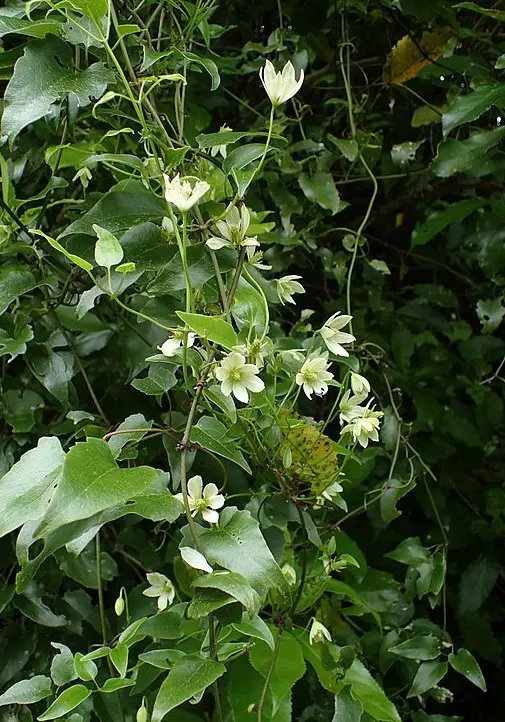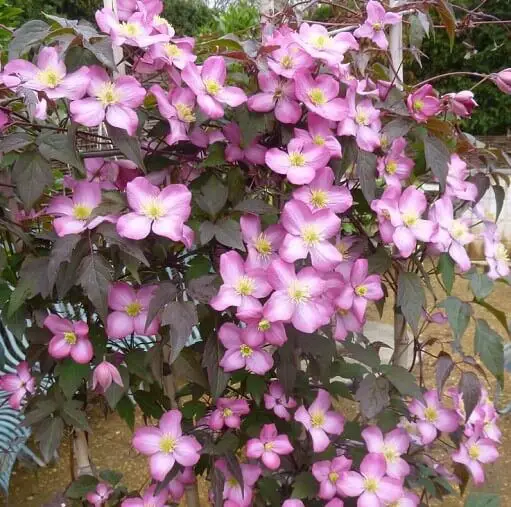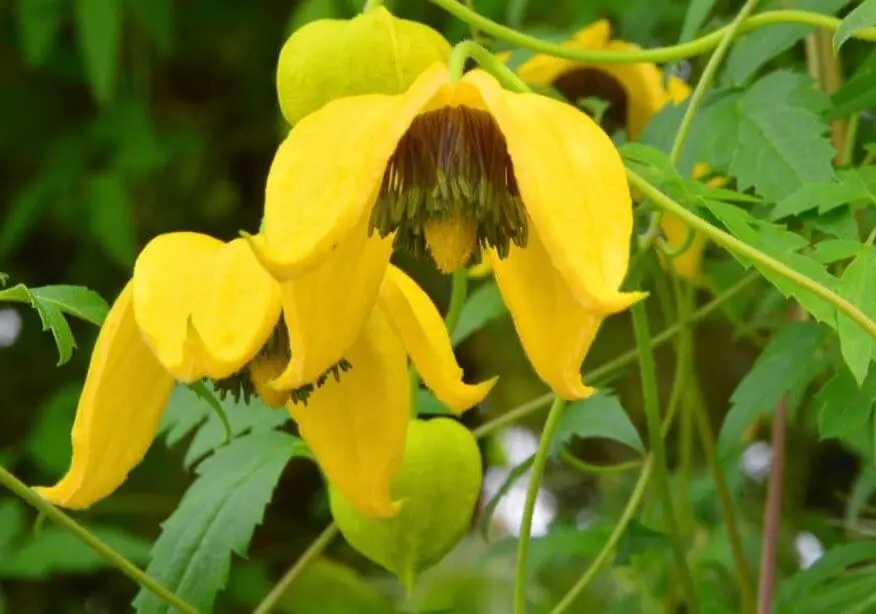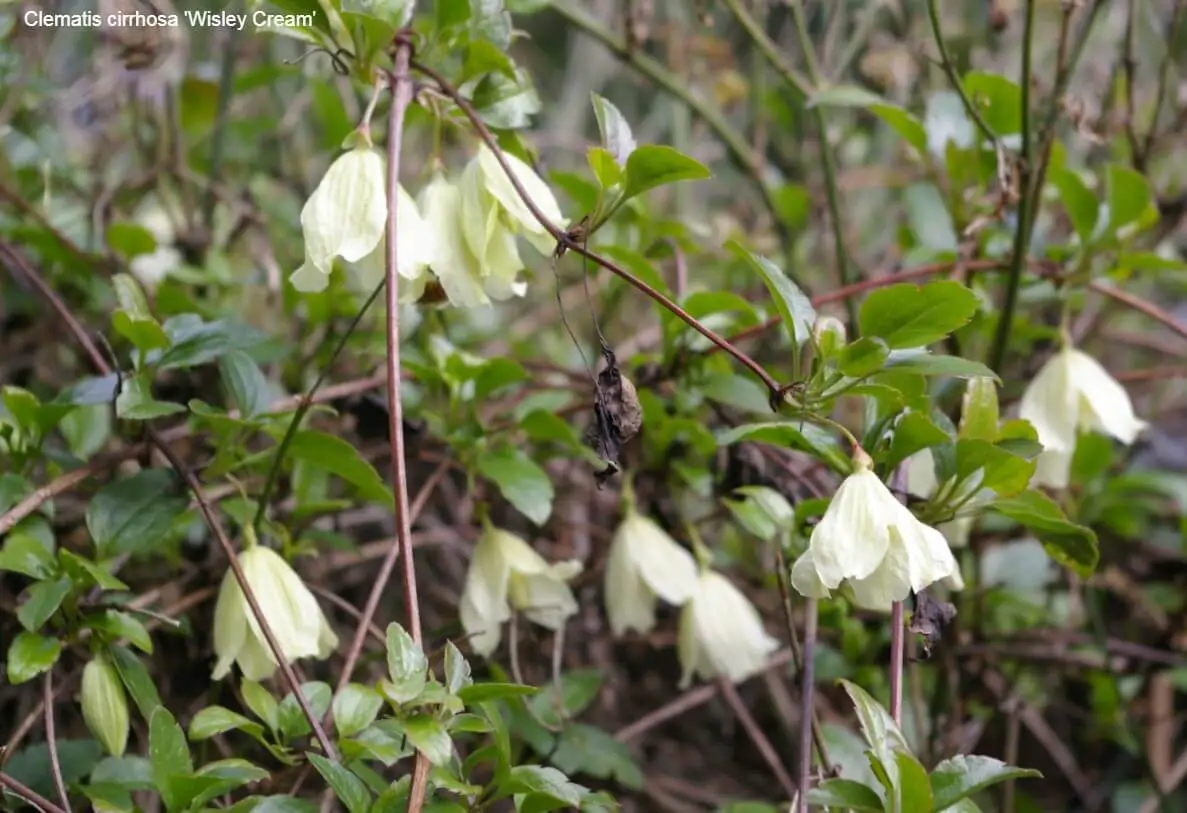Clematis: Varieties, Growing And Care For Leather Flower
Clematis, a versatile flowering vine, offers a wide range of varieties that can thrive in various habitats and be used for diverse gardening purposes. With three main groups of clematis – Early Flowering, Early Large Flowered, and Late Flowering – gardeners can find the perfect variety to suit their needs. From spring-blooming Clematis alpina ‘Frances Rivis’ to autumn-flowering Clematis ‘Jackmanii Rubra’, there’s a type of clematis that will provide year-round interest.
Some varieties are well-suited for specific purposes, such as Clematis Propertius for early summer flowers or Clematis Gypsy Queen for late summer blooms. When it comes to growing clematis in a rose garden, pruning is crucial. The first year’s pruning is particularly important to establish a strong foundation for the plant.
There are various pruning methods and schedules depending on the type of clematis, but general guidelines include tidying up after flowering or performing a light prune in February or March.
Types of Clematis
Clematis varieties are typically categorized into three distinct groups. The first group comprises early-flowering types that bloom from late winter to early spring, with some varieties requiring minimal pruning if any at all. These clematis plants often produce their vibrant flowers in a short window of time. In contrast, the second group features large-flowered varieties that typically burst forth into bloom later in the spring season.
Finally, the third and final group consists of late-blooming clematis types that flourish from mid-summer to early autumn, offering a visually stunning display as the seasons transition.
Early Flowering Clematis
While many clematis species and cultivars produce flowers on previous summer’s shoots, it’s essential to note that some may require protection from severe or prolonged frost. As a general rule, these plants are hardy, but some types might need a little extra care during harsh winter conditions.
Characterized by small, delicate flowers and deciduous growth habits, clematis don’t typically demand pruning. However, it’s still crucial to deadhead spent blooms to encourage more flowering.
Any pruning should be done judiciously, as over-zealous trimming can hinder the plant’s natural development.
On the other hand, a light prune can actually stimulate future growth for the next season. When it comes to early-flowering clematis, popular species and cultivars include clematis Montana, clematis Alpina, and clematis Macropetala. By understanding these unique characteristics and requirements, you’ll be better equipped to provide the right conditions for your clematis to thrive.
Early Large Flowered Clematis
These clematis varieties, such as Clematis henryi and Clematis picardy, are entirely hardy and showcase an impressive diversity. Their large flowers thrive when sheltered from intense wind or excessive rainfall, making them well-suited for training through other plants that provide protection from extreme weather conditions. Interestingly, many species within this group not only bloom on second-year growth but also produce a second display off current-season side shoots if properly pruned.
Late Flowering Clematis
Many late-blooming clematis varieties boast both small and large, showy flowers. Among these, the highly sought-after Clematis jackmanii Superba stands out as a popular choice. Meanwhile, herbaceous species also fall within this category, characterized by their robust growth and ability to thrive in a variety of settings.
What sets these late-flowering clematis apart is that they produce blooms on their current season’s growth, making them an excellent option for gardeners seeking vibrant color and low maintenance.
Clematis Varieties For Different Purposes
When it comes to utilizing clematis, one of its most popular uses is as a climber. Depending on the variety, different types of clematis can thrive in various settings:As a backdrop through a tree – finding the right match between the clematis and the tree is crucial. Conifers are generally tolerant of climbers, making clematis chrysocoma an excellent choice for this setup.
As a complement to shrubs – with many varieties to choose from, it’s essential to select one that complements the shrub in terms of appearance and flowering seasons. This way, by managing the clematis or the shrub, you can create an extended display of blooming colors. Popular pairings include roses and penstemons, while Clematis Fireworks is a favorite for its vibrant blooms. Growing up a wall – although this is often the desired purpose for clematis, not all types thrive in this setting.
The best varieties for growing as a single plant against a wall are typically found within the montana clematis species, with Clematis montana Grandiflora being a popular choice. For ground cover, Clematis viticella Alba Luxurians is an excellent option due to its small, delicate flowers. If you’re looking for varieties suitable for container gardening, options like Clematis macropetala Maidwell Hall can thrive in almost any position, while Clematis Carnaby excels in shady locations.
Lastly, clematis can also be used as a cut flower, particularly with the viticella varieties. These flowers are best used as a support for the main arranged display, but they typically don’t have a long lifespan.
Clematis Varieties for Year Round Flowers
Clematis, with their striking beauty, offer an unparalleled level of versatility and practicality in any garden. These climbing wonders thrive across a 12-month bloom period, starting from January to December. Their adaptability is further emphasized by the fact that they can be grown in various sizes – ranging from two to forty feet tall – making them suitable for gardens with diverse conditions.
Whether it’s a sunny spot or the shade of a north-facing wall, clematis will happily grow and flourish. They can be trained to cover trellises, pergolas, or hedges, while also scrambling through trees. The array of flower shapes and sizes is equally impressive, featuring large saucers measuring 6-8 inches across, opulent double blooms, and delicate nodding bells.
By selecting a few different clematis varieties from the list below, you can enjoy a continuous succession of flowers throughout the year, with each month bringing its own unique bloom.
Spring Flowering Clematis





When it comes to clematis varieties that bloom early in the spring, Clematis Armandii stands out for its remarkable length of flowering season. However, Apple Blossom (10-12 feet) is a close second, boasting stunning pink and white scented blooms that measure 2 inches in diameter from March to May. Other notable spring-flowering clematis varieties include Frances Rivis’, which produces delicate blue and white bell-shaped flowers measuring 2 inches in diameter, growing to be around 6-8 feet tall.
Doctor Ruppel’ is another popular choice, featuring open pink and white barred blooms that measure 8 inches in diameter, blooming twice a year from April to May and again from August to September. The clusters of green and cream scented bell flowers produced by Clematis forsteri reach heights of 6-8 feet, while Clematis macropetala ‘Markham’s Pink’ flaunts pink and mauve semi-double blooms measuring 2.5 inches in diameter, growing to be around 8-10 feet tall.
Finally, Propertius produces deep pink semi-double feathery bell flowers that measure 3 inches in diameter, blooming twice a year from April to May and again from July to August, reaching heights of 6-8 feet.
Early Summer Flowering Clematis





Early summer is the prime time to witness a stunning display of clematis flowers, with many varieties showcasing their vibrant blooms. Among the most impressive are several notable cultivars, including: Clematis ‘Beauty of Worcester’, boasting deep blue double flowers measuring 6.
5 inches in diameter, as well as single blooms in August-September, growing up to 8 feet tall; Clematis ‘Miss Bateman’, featuring 6-inch white flowers with red anthers in May-June and reaching a height of 6-8 feet; Clematis ‘Montana Freda’, producing masses of deep pink 2-inch flowers in May-June, also reaching 6-8 feet in height; Clematis ‘Nelly Moser’, showcasing enormous pink/white barred flowers measuring 7-8 inches in diameter in May-June and growing up to 10 feet tall; and finally, Clematis ‘The President’, featuring 7-inch purple-blue open flowers in May-June and again in August-September, with a height range of 8-10 feet.
Late Summer Flowering Clematis











Late summer brings another wave of clematis blooms, featuring a diverse range of varieties and flower sizes. Among these are several groups that include Clematis alpina ‘Hagley Hybrid’, which produces shell pink flowers measuring six inches in diameter from June to September. This variety stands at an impressive 6-8 feet tall. Also blooming during this period is Clematis ‘Ernest Markham’, a deep magenta-red flowered clematis that reaches the same height as Hagley Hybrid.
Heavy pruning can delay its flowering period, extending it from August to October. Next is Clematis florida ‘sieboldii’, which boasts 3-4 inch white flowers with a striking purple center, also blooming from June to September and standing at an identical 6-8 feet. Gypsy Queen produces deep purple flowers measuring seven inches in diameter from July to September, while Clematis ‘Henryi’ offers open white blooms with ornate brown anthers, also flowering from June to August.
Heavy pruning can delay Henryi’s blooming period as well, extending it from August to October and reaching the same height of 6-8 feet. Niobe’s striking wine red flowers measure six inches in diameter and bloom from June to August, standing at the same height as its companions. Clematis ‘Parisienne’ produces open violet/blue flowers with red anthers in both June/July and September/October, although it stands slightly shorter at 3-4 feet tall.
Piilu’s double mauve/pink blooms measure 3-4 inches in diameter and feature white markings, blooming in June/July followed by single flowers in September. This variety reaches an average height of 5-6 feet. Lastly, Clematis texensis ‘Etoile Rose’ produces open bell-shaped pink/white flowers measuring 2.5 inches in diameter from June to August, standing at the same impressive height of 6-8 feet as many of its companions.
For those looking for a more exotic option, Clematis vitalba, also known as Travellers Joy, offers masses of small white star-shaped flowers in July/August and can be grown in a ‘wild’ garden setting, although it may spread aggressively. Clematis viticella ‘Etoile Violette’, on the other hand, produces open dark purple blooms with yellow anthers, measuring 3.5 inches in diameter from July to September and reaching an average height of 8-10 feet.
Autumn Flowering Clematis





To coax some summer flowering varieties into blooming in the autumn, try giving them a hard prune. Certain Clematis species are naturally inclined to produce flowers at this time of year, including the likes of ‘Jackmanii Rubra’, which boasts semi-double, dark crimson blooms measuring 6 inches that appear from May/June and then single flowers from August to October, growing up to 8-12 feet tall.
Another popular choice is Clematis tangutica Bill Mackenzie, which produces 3-inch yellow bell-shaped flowers from August to November, accompanied by ornamental seed tassels, reaching heights of 10-15 feet. The Clematis texensis Gravetye Beauty is also worth mentioning, with its deep red, 2.5-inch blooms appearing from July to October and growing up to 8-10 feet tall. For a pop of golden yellow, try the 1.
5-inch open, nodding flowers of Clematis tibetana Orange Peel, which bloom from August to November and reach heights of 8-12 feet. Finally, Clematis viticella Polish Spirit produces 3.5-inch purple flowers with red anthers from August to October, growing up to 8-10 feet tall.
Winter Flowering Clematis




While many people think of clematis as a warm weather plant, the truth is that there are several varieties that can thrive during the winter months. In fact, these four types are particularly well-suited for enjoying during this time. Clematis cirrhosa Freckles produces nodding white bells with maroon freckles from October to February, and its evergreen foliage means it remains attractive even in the dead of winter. It grows 8-10 feet tall.
If you’re looking for a slightly different color scheme, Clematis cirrhosa Wisley Cream is a great choice. Its nodding cream bells bloom from January to March, and like Freckles, its evergreen foliage ensures it remains visually appealing during the winter months. This variety grows 10-12 feet tall. For a more subtle look, Clematis urophylla Winter Beauty produces 1.5-inch cream/white bells from December to February. Its evergreen foliage is also attractive year-round, and it grows 12 feet tall.
Last but not least, Clematis napaulensis offers a unique combination of green/cream flowers with red anthers that bloom from November to March. Although it goes dormant in the summer, this variety’s winter blooms make up for its lack of activity during the warmer months. It grows 15-20 feet tall.
How to Grow Clematis Vines in a Rose Garden

Growing a perennial plant grouping of roses and clematis is an excellent choice for a summer garden. The two plants share similar cultural needs, including the requirement for annual pruning as part of their maintenance schedule. This combination offers several benefits, such as attracting butterflies to roses and providing fragrant flowers that can be used in arrangements. Additionally, clematis varieties with fragrance can also serve as a natural deer deterrent.
When choosing varieties, consider those that are disease-resistant, hardy in your local region, and develop attractive hips after flowering for winter interest. With some plants growing to varying heights, this combination is suitable even for smaller gardens.
How to Plant Clematis and Roses Together
When planning a garden with sequence flowering, selecting plants that bloom at different times or overlap their blooming periods ensures a longer span of blooms. For instance, roses are typically summer-blooming, but some varieties have extended blooming periods. Clematis, on the other hand, can be chosen based on early, middle, or late blooming time-frames.
Autumn-blooming clematis like Clematis terniflora produce fragrant white flowers and offer a unique opportunity to add variety to the garden’s bloom schedule.
When combining roses and clematis in the same bed, plant size and spacing become crucial considerations. Different varieties of both plants have distinct height, spread, and space requirements that must be taken into account when making planting decisions.
For instance, Clematis requires at least two feet of clearance from a climbing rose bush to prevent overcrowding.
Another challenge in growing roses and clematis together is ensuring adequate water supply. Roses typically require about one inch of water per week, while clematis demand a significant amount of moisture as well. Both plants thrive in moist, well-draining soil that has been amended with organic matter.
To maintain the health and growth of both roses and clematis, regular pruning is essential. Clematis, for example, can be pruned based on its flowering time, while roses require pruning according to their bush type. Additionally, deadheading dried flowers on roses helps keep them healthy.
Climbing Roses Intertwinded with Clematis
Climbing roses and clematis have a long-standing partnership, with many climbers sharing a common bond with these flowering shrubs. Hardy in zones 2-8, depending on the variety, older climbers known as ramblers are remarkably resilient plants that can grow up to 30 feet tall and spread out around 6 feet.
These climbing rose varieties offer endless inspiration:Rosa ‘New Dawn’ boasts continual blooms of pink and white hues, withstanding temperatures up to zone 4 and boasting disease-resistant qualities. Rosa ‘Compassion’ features petals in a harmonious blend of pink and apricot colors, creating a mesmerizing floral display. Its continuous flowering habit makes it an excellent choice for gardeners seeking low-maintenance beauty.
Rosa ‘American Beauty’, an older variety, is distinguished by its vibrant red, fragrant blooms that can grow up to six feet tall. However, it may struggle in cool summer climates. Meanwhile, floribundas are another type of rose bush that tends to grow around three feet high. These compact bushes pair beautifully with lower-growing clematis as the vines weave through the clumps of roses, creating a lush tapestry of color and texture.
Shrub Roses Supporting Clematis
The shrub rose is an excellent option for those looking for lower-maintenance roses that can thrive under clematis or require less pruning. Two notable cultivars include ‘Knock Out’ and ‘The Fairy’, both well-known for their unique characteristics. Another popular shrub rose, ‘Bonica’, boasts stunning shell-pink blooms that create a stunning display when in full bloom. This robust rose bush is surprisingly easy to grow, making it an excellent choice for gardeners of all skill levels.
The Flower Carpet series also offers a mass of blooms, but its hardiness is limited to zones 5-10, making it more suitable for southern climates.
Growing Clematis in a Rose Garden
In a summer garden blessed with full sun, clematis and roses can thrive together in perfect harmony. However, it’s essential to provide each plant with sufficient space to prevent overcrowding, which can lead to poor air circulation and an increased risk of powdery mildew issues. By allowing for ample room between these beautiful blooms, you’ll be able to enjoy a lush and vibrant display without the added concern of fungal diseases.
How and When to Prune Climbing Clematis Plants

Clematis, often referred to as the Queen of Climbers, is a beloved garden plant known for its stunning flowering displays. These climbing shrubs can be trained to scale trellises or pergolas, scramble up trees, or thrive in patio containers. While clematis are generally easy to grow, with most varieties being fully hardy and tolerant of both sun and shade, pruning requires some consideration to achieve the best results.
Unlike other plants, clematis will accept heavy pruning at almost any time of year without suffering significant harm. However, for optimal growth and flowering, it’s essential to prune different varieties differently, taking care to make clean cuts just above a joint to stimulate fresh bud development. To guide gardeners in their pruning efforts, we’ll explore the specific requirements for some popular clematis varieties below.
First Year Pruning
In their initial year, it’s essential to heavily prune clematis to stimulate robust root development and optimal branching. For this purpose, cut them back down to a joint featuring viable buds, approximately 6-9 inches above the ground level. This pruning process can be performed either at the time of planting or shortly after flowering for Category 1 varieties. For all other categories, it’s recommended to prune in February or March of the subsequent year.
This heavy pruning technique can also be repeated throughout a plant’s life cycle to rejuvenate and promote more vigorous growth.
Category 1 – Tidy After Flowering
For the majority of clematis varieties, a simple trim to promote branching or tidy up any unwanted growth is sufficient. Those that grow tall can be left to their natural height unless they become unruly, at which point pruning may be necessary to maintain control.
Some popular cultivars and species in this group include Clematis alpina, Clematis cirrhosa, Clematis macropetala, Clematis montana, evergreen clematis, Frances Rivis, Freckles, montana Elizabeth, Freda, Grandiflora, Markham’s Pink, Wisley Cream, Winter Beauty, and napaulensis.
Category 2 – Light Prune In February or March
When it comes to pruning your clematis, start by shortening the tips of strong stems with good bud set. Then, tidy up any unwanted growth and remove any dead wood from the plant. For weak shoots, take a more drastic approach and cut them back hard. This category includes early large-flowered hybrid clematis varieties, such as Beauty of Worcester, Dr Ruppel, Jackman’s III Rubra, Miss Bateman, Nelly Moser, Piilu, and The President, which are all popular and well-loved choices among gardeners.
Category 3 – Hard Prune In February Or March
To prune your clematis effectively, cut back all growth to a strong leaf joint about 1-2 feet above the ground. With so many varieties to choose from, you’ll have plenty of options for creating a stunning display. Some popular types include Clematis Florida, Clematis Integrifolia, and Clematis Tangutica, as well as late-blooming hybrids like the large-flowered cultivars.
You can also consider more specific options like Angelique, x Durandii, Florida sieboldii, Gypsy Queen, Hagley Hybrid, Parisienne, Petit Faucon, Rooguchi, tangutica Bill Mackenzie, texensis Etoile Rose, Gravetye Beauty, Princess Diana, tibetana Orange peel, and viticella Etoile Violette, as well as Polish Spirit. Each variety offers its own unique characteristics and benefits, so take the time to explore and find the one that best suits your needs.
Category 4 – Optional Pruning
Clematis varieties can be manipulated to produce blooms at different times through pruning techniques. For instance, Category 2 pruning will result in flowers blooming at the usual time, whereas a more drastic approach like Category 3 pruning will bring forth blooms approximately two months later.
This flexibility applies to certain clematis varieties, such as Clematis Barbara, Carnaby, Ernest Markham, Henryi, Marie Boisselot, Monte Cassino, and Niobe, offering growers the opportunity to tailor their cultivation strategies to suit specific needs or preferences.
Pruning For Clematis: Types and Methods
While pruning all types of clematis share some commonalities, each variety has unique requirements that must be taken into account. By first identifying the specific type of clematis you’re working with, the task becomes significantly more manageable. The process itself is relatively straightforward, aiming to maintain a balanced appearance for the plant.
As you carefully navigate the delicate tendrils of your clematis, it’s essential to employ the right technique and be patient, as these factors can greatly impact the outcome.
General Points
To prevent clematis stems from becoming bare and weak, it’s essential to maintain their shape by pruning them regularly. When young, you can achieve this by pinching out new growth to encourage bushy development lower down on the stem. As the plant matures, more substantial pruning is necessary. Start with a hard prune in its first spring, removing any weak or spindly growth just above a set of healthy buds around 12 inches from the base.
The timing and location of this pruning will vary depending on the type of clematis you’re growing, as well as when it flowers.
Early Flowering Clematis
When left untended, this group of flowers tends to thrive in early summer. However, if pruned radically and suddenly, they may suffer for several seasons afterwards. To promote balanced and consistent growth, it’s recommended to prune these types – including Clematis montana, Clematis alpina, and Evergreen Clematis armandii – shortly after each season’s flowering cycle by removing any dead, damaged, or weak stems. This will help maintain the overall health of the plant.
Notably, Clematis montana requires more vigorous pruning once established to prevent overgrowth, whereas Clematis alpina typically needs minimal attention.
Early Large Flowered Clematis
When it comes to maintaining the health and appearance of your clematis, proper pruning is crucial. For damaged or weak growth, removal is the best course of action, while strong established vines should be pruned back to the strongest buds in spring, before new growth begins. This approach can help prolong the flowering season by staggering the pruning on different parts of the plant.
Additionally, many clematis varieties can thrive with minimal attention year-round, followed by a hard prune every three to four years without compromising their overall health.
Late Flowering Clematis

When pruning clematis, it’s essential to encourage future growth by cutting back shoots to a height of around 15-20 inches. This promotes additional new development later in the season. As winter begins to wind down, varieties like Clematis jackmanii and Clematis viticella should be pruned back to 9-18 inches above ground. However, if some cultivars have already started producing new growth ahead of schedule, careful consideration will be necessary.
Since these varieties produce fresh stems annually from their base, pruning can occur every year in late winter or early spring.
Related Posts
As you prepare to send or receive flowers, have you ever stopped to consider the etiquette surrounding gratuities for your flower delivery courier? In this context, tipping is not only appreciated but also expected. The amount and method of the tip vary depending on factors such as location, service quality, and personal preference. Meanwhile, we’re often confronted with weeds bearing yellow flowers – those pesky dandelions and their sunflower cousins.
Understanding how to identify and remove them can be a valuable skill for any gardener. On the other hand, if you’re seeking a pop of color in your partial shade garden or container, consider incorporating some vibrant perennials like astilbe into your landscape design. For those with African violets, we’ve put together a comprehensive guide on how to grow and care for this lovely flowering plant.
And finally, if you’re looking to add some depth and interest to your cold climate shade garden, our top ten list of shade perennials will provide inspiration and guidance.






